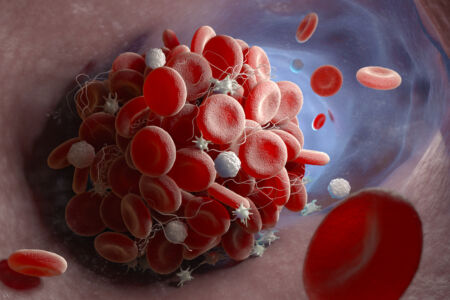
The CDC has launched a public service campaign to raise awareness about risk factors for deep vein thrombosis.
The Centers for Disease Control and Prevention (CDC) and the National Blood Clot Alliance have launched a “Stop the Clot” campaign to increase public awareness about the dangers of deep vein thrombosis (DVT). DVT is a blood clot that forms in a deep vein of the legs. If the clot breaks free, it could lodge in the lungs, causing a pulmonary embolism (PE), a potentially life-threatening medical emergency.
According to the CDC, DVT affects roughly 900,000 Americans each year. DVT can happen to anyone, although there are a number of risk factors that increase the chances of developing a dangerous blood clot. Knowing your risk factors can help you stay safe.
In some cases, DVT may be caused by treatment for another condition. For example, prolonged confinement after surgery and cancer therapy heightens the potential for DVT. Having a family history of blood clots also increases the likelihood you may experience one.
Pregnant women and women taking hormone replacements are at greater risk of DVT. Lifestyle plays a role, as well; not exercising and carrying extra pounds have been identified as risk factors for DVT. DVT also tends to strike people over the age of 55 more frequently.
Beyond those factors, simply sitting at a desk or on a plane for long hours creates the conditions conducive to DVT — that is, poor circulation due to stagnant blood flow. That’s why it’s recommended you move around as much as possible when you travel by plane or car.
A recent study from Taiwan suggested another risk factor: varicose veins. Varicose veins stem from venous insufficiency, or an inability of the tiny valves in the vein to pump blood from the extremities back to the heart. These impaired valves trap blood in the vein, which eventually leads to the emergence of bulging varicose veins on the legs and feet.
A 2018 research paper investigated the connection between DVT and varicose veins. It concluded varicose veins increased the possibility of developing DVT by 5.3 times. However, the researchers noted more research is needed to discover whether varicose veins cause DVT, or if the two merely share many of the same characteristics of poor circulation in the extremities.
Once you know your risk factors, you can discuss prevention tips with a vein specialist. If you have one blood clot event, it’s even more important to avoid another. The CDC estimates three out of 10 people who have had a blood clot will experience a second one within 10 years.
Any signs of DVT must be immediately checked by a doctor. These include swelling in the leg, pain, tenderness, red or discolored skin, or a warm feeling on the skin. Symptoms of a PE range include difficulty breathing, chest pain, irregular heart beat, or coughing up blood. If you experience any of those symptoms, you should go to the emergency room for immediate treatment.
To treat DVT, your doctor will prescribe either anticoagulants (blood thinners) to prevent clots or a class of drugs known as thrombolytics to break up an existing clot. A filter may also be placed in the vena cava, a large vein in the body that transports blood from the lower body to the heart, to block clots from reaching the lungs.
At the Center for Vein Restoration, we’ll assess your risk factors for DVT and recommend therapies. Treatment doesn’t necessarily mean medical intervention. You can avoid DVT by making lifestyle changes such as losing weight, staying active, and wearing compression stockings to promote circulation. Make an appointment today and join millions of Americans who want to “stop the clot.”